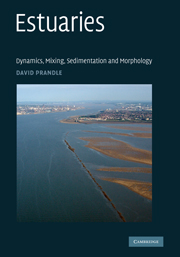Book contents
- Frontmatter
- Contents
- List of symbols
- 1 Introduction
- 2 Tidal dynamics
- 3 Currents
- 4 Saline intrusion
- 5 Sediment regimes
- 6 Synchronous estuaries: dynamics, saline intrusion and bathymetry
- 7 Synchronous estuaries: sediment trapping and sorting – stable morphology
- 8 Strategies for sustainability
- Index
- References
2 - Tidal dynamics
Published online by Cambridge University Press: 01 September 2009
- Frontmatter
- Contents
- List of symbols
- 1 Introduction
- 2 Tidal dynamics
- 3 Currents
- 4 Saline intrusion
- 5 Sediment regimes
- 6 Synchronous estuaries: dynamics, saline intrusion and bathymetry
- 7 Synchronous estuaries: sediment trapping and sorting – stable morphology
- 8 Strategies for sustainability
- Index
- References
Summary
Introduction
Tidal propagation in estuaries can be accurately simulated using either numerical or hydraulic scale models. However, such models do not directly provide understanding of the basic mechanisms or insight into the sensitivities of the controlling parameters. Thus, while terms representing friction and bathymetry appear explicitly in (2.8) and (2.11), it is not immediately evident why tides are greatly amplified in certain estuaries yet quickly dissipated in others. The aim here is to derive analytical solutions, and thereby Theoretical Frameworks, to guide specific modelling and monitoring studies and provide insight into and perspective on estuarine responses generally.
Much of the theory developed here assumes that tidal propagation in estuaries can be represented by the shallow-water wave equations reduced to a 1D cross-sectionally averaged form. Section 2.2 describes the bases of this simplification. By further reducing these equations to a linear form, localised solutions are readily obtained, these are examined in Section 2.3.
It is shown in Section 2.4 that by introducing geometric expressions to approximate estuarine bathymetry, whole-estuary responses can be determined. Tidal responses in estuaries are shown for geometries approximated by (i) breadth and depth variations of the form BL(X / λ)n and HL(X / λ)m, where X is the distance from the head of the estuary, i.e. the location of the upstream boundary condition at the limit of tidal influence; (ii) breadth and depth varying exponentially and (iii) a ‘synchronous’ estuary.
- Type
- Chapter
- Information
- EstuariesDynamics, Mixing, Sedimentation and Morphology, pp. 23 - 49Publisher: Cambridge University PressPrint publication year: 2009



